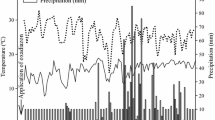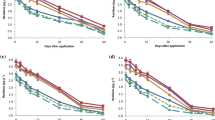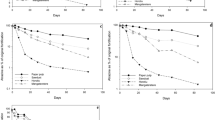Abstract
Rotenone dissipation and terminal residue in cabbage and soil under field conditions were determined by high-performance liquid chromatography. The dissipation rates of rotenone were described using first-order kinetics. The half-lives ranged from 0.89 to 1.55 days in cabbage and 1.98 to 2.76 days in soil. Prolonged pre-harvest interval times ensure that the cabbage is safe for consumption. Temperature and the physico-chemical properties of the soil were identified as the key factors affecting rotenone degradation in cabbage and soil under field conditions.



Similar content being viewed by others
References
Angioni A, Cabizza M, Cabras M, Melis M, Carlo T, Cabras P (2004) Effect of the epicuticular waxes of fruits and vegetables on the photodegradation of rotenone. J Agric Food Chem 52:3451–3455
Betarbet R, Sherer TB, McKenzie G, Garcia-Osuna M, Panov AV, Greenamyre JT (2000) Chronic systemic pesticide exposure reproduces feature of Parkinson’s disease. Nat Neurosci 3:1301–1306
Cabras P, Caboni P, Cabras M, Angioni A, Russo M (2002) Rotenone residues on olives and in olive oil. J Agric Food Chem 50:2576–2580
Casacchia T, Sofo A, Toscano P, Sebastianelli L, Perri E (2009) Persistence and effects of rotenone on oil quality in two Italian olive cultivars. Food Chem Toxicol 47:214–219
Cavoski I, Caboni P, Sarais G, Cabras P, Miano T (2007) Photodegradation of rotenone in soils under environmental conditions. J Agric Food Chem 55:7069–7074
Cavoski I, Caboni P, Sarais G, Miano T (2008) Degradation and persistence of rotenone in soils and influence of temperature variations. J Agric Food Chem 56:8066–8073
Gingerich WH (1986) Tissue distribution and elimination of rotenone in rainbow trout. Aquat Toxicol 8:27–40
Haley TJ (1978) A review of the literature of rotenone, 1, 2, 12, 12a-tetrahydro-8, 9-dimethoxy-2-(1-methylethenyl)-1-benzopyrano[3, 5-b]furo[2, 3-h][1]benzopyran-6(6 h)-one. J Environ Pathol Toxicol 1:315–317
Heikkila RE, Sonsalla PK (1987) The use of the MPTP-treated mouse as an animal model of parkinsonism. Can J Neurol Sci 14:436–440
Isman MB (2006) Botanical insecticides, deterrents, and repellents in modern agriculture and an increasingly regulated world. Annu Rev Entomol 51:45–66
Jenner P (2001) Parkinson’s disease, pesticides and mitochondrial dysfunction. Trends Neurosci 24:245–246
Liang HW, Li L, Li W, Wu YJ, Zhou ZQ, Liu FM (2011) Dissipation and residue of dimethomorph in pepper and soil under field conditions. Ecotox Environ Safe 74:1331–1335
McClay W (2000) Rotenone use in North America. In: Finlayson BJ et al (eds) Rotenone use in fisheries management. Administrative and technical guidelines manual, American Fisheries Society, pp 15–27
Newsome WH, Shields JB (1980) Residues of rotenone and rotenolone on lettuce and tomato fruit after treatment in the field with rotenone formulations. J Agric Food Chem 28:722–724
Acknowledgments
This work was supported by the Institute for the Control of Agrochemicals, Ministry of Agriculture of the People’s Republic of China and Guangdong Yuentin Biological Engineering CO., Ltd. (Guangdong, People’s Republic of China).
Author information
Authors and Affiliations
Corresponding author
Rights and permissions
About this article
Cite this article
Zhou, Y., Zhang, N., Wang, K. et al. Dissipation and Residue of Rotenone in Cabbage and Soil Under Field Conditions. Bull Environ Contam Toxicol 91, 251–255 (2013). https://doi.org/10.1007/s00128-013-1040-5
Received:
Accepted:
Published:
Issue Date:
DOI: https://doi.org/10.1007/s00128-013-1040-5




